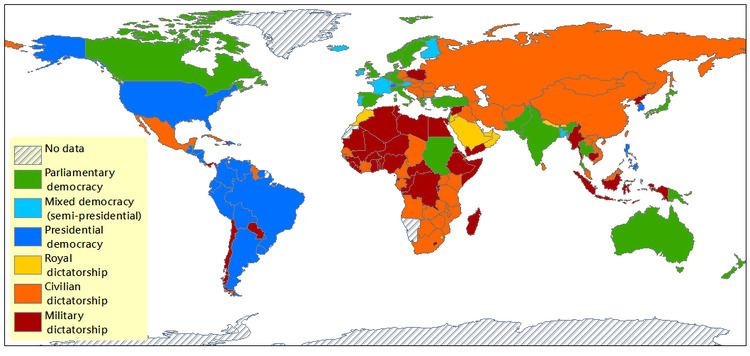 | ||
Democracy-Dictatorship (DD), index of democracy and dictatorship or simply the DD index or the DD datasets refers to the binary measure of democracy and dictatorship first proposed by Adam Przeworski et al. (2010), and further developed and maintained by Cheibub, Gandhi, and Vreeland (2009).
Contents
- Six fold regime classification scheme and its rules
- Four rules
- The regimes with type2 value of 1 2008
- Comparison with other democracy measuring data sets
- References
Based on the regime binary classification idea proposed by Alvarez in 1996, and the Democracy and Development (or DD measure, ACLP datatset) proposed by Przeworski et al. (2010), Cheibub, Gandhi, and Vreeland developed a six-fold regime classification scheme, resulting what the authors called as the DD datasets. :68
The DD dataset covers the annual data points of 199 countries from 1946 (or date of independence) to 2008. :68 The figures at the left show the results in 1998 and 2008.
Six-fold regime classification scheme and its rules
The DD index first classifies the regimes into two types: democracies and dictatorships. For democracies, it categorizes them into three types: parliamentary, semi-presidential and presidential democracies. For dictatorships, monarchic, military and civilian dictatorship.
Based on a “minimalist” theory of democracy, the index rely on rules regarding the existence of competitive elections. Resorting to democratic concepts by Karl Popper and Joseph Schumpeter, Przeworkski defended the minimalist approach, citing Popper that "the only system in which citizens can get rid of governments without bloodshed" .
Four rules
For a regime to be considered as a democracy by the DD scheme, it must meet the requirement of four rules below::69
- The chief executive must be chosen by popular election or by a body that was itself popularly elected.
- The legislature must be popularly elected.
- There must be more than one party competing in the elections.
- An alternation in power under electoral rules identical to the ones that brought the incumbent to office must have taken place.
Some regimes may meet the first three rules, but lack an alternation in power in its historical past; these regimes are classified as dictatorships and marked with a type II value, signalling potential classification errors where a democratic regime may be falsely classified as dictatorship:70.
The authors acknowledged that the last rule is more complicated to implement but argued that it helps researchers to control potential errors and enhance the classification schemes' scientific reproducibility :70.
In DD dataset, the Type II variable does not indicate cases of semi-democracy or cases of semi-dictatorship :71.
The regimes with type2 value of 1 (2008)
For the regimes with type2 of 1, the following list compares the similarities and contrasts between the 2008 data points from the DD dataset and the Polity IV .
Comparison with other democracy-measuring data sets
The DD dataset is limited to 199 countries after 1946, whereas Boix, Miller, & Rosato, 2013 proposed a data set from 1800 to 2007, covering 219 countries. The 2010 version of Polity data series covers 189 countries from 1800 to 2009.
Gugiu&Centellas developed the Democracy Cluster Classification Index that integrates five democracy indicators (including the DD dataset, Polity dataset, etc.), clustering 24 American and 39 European regimes over 30 years.
